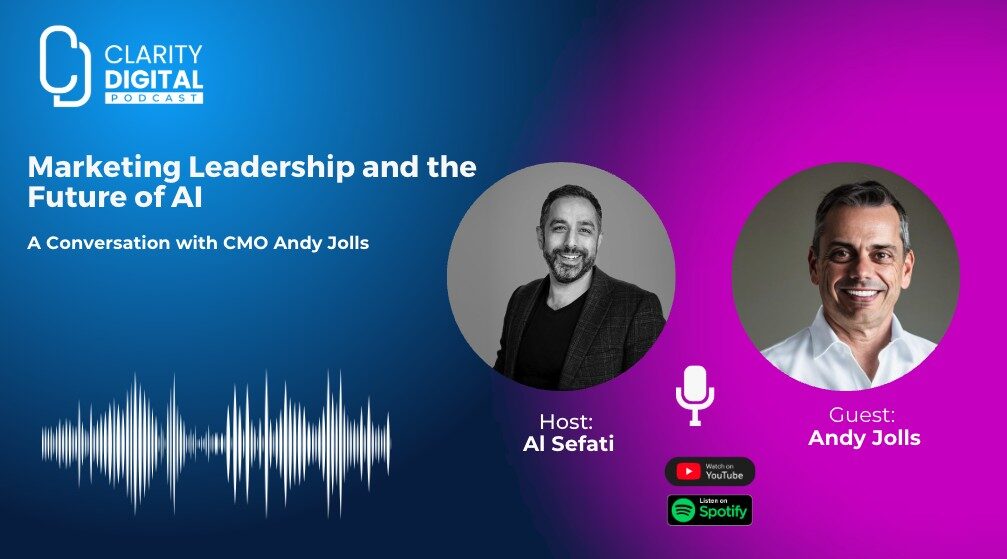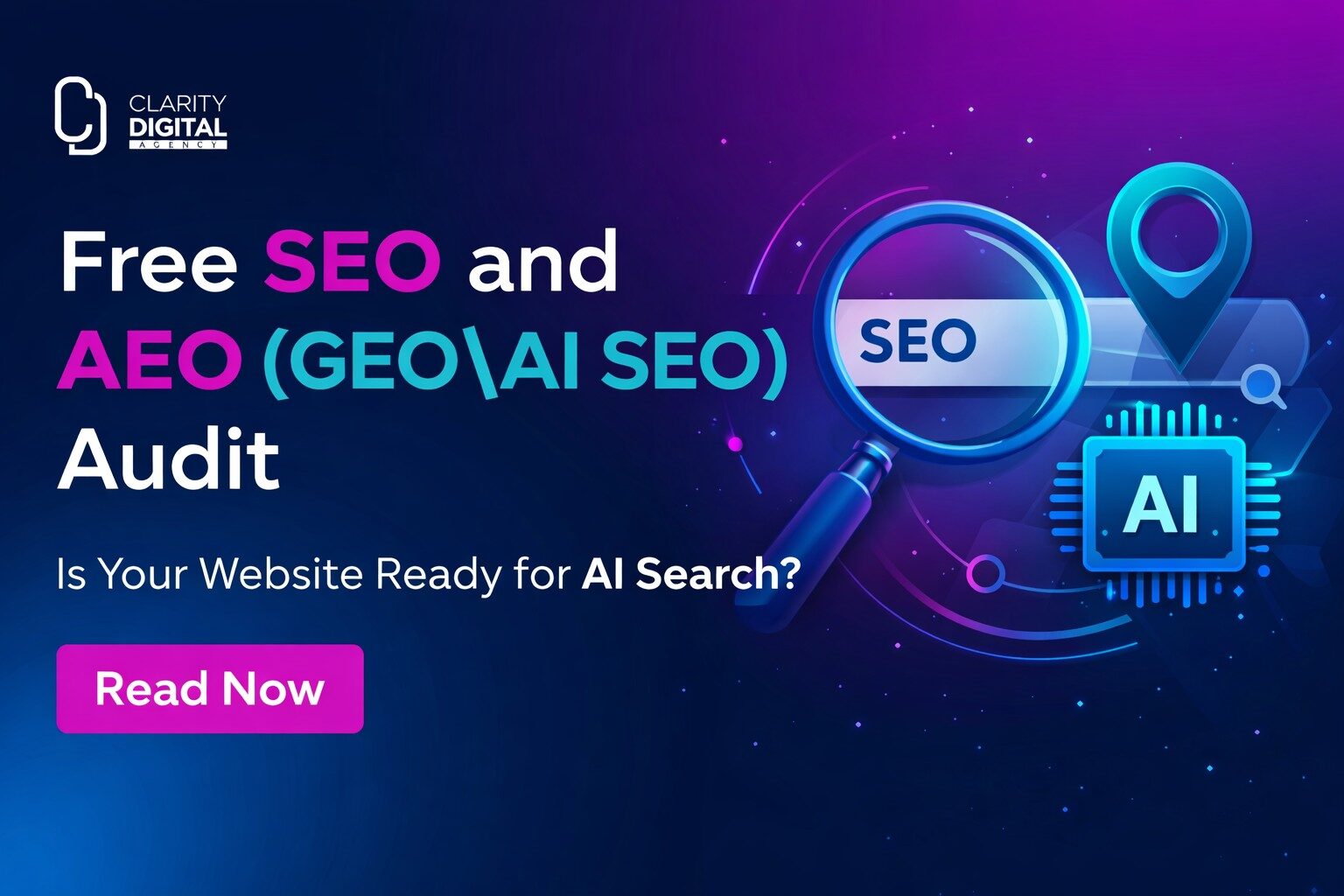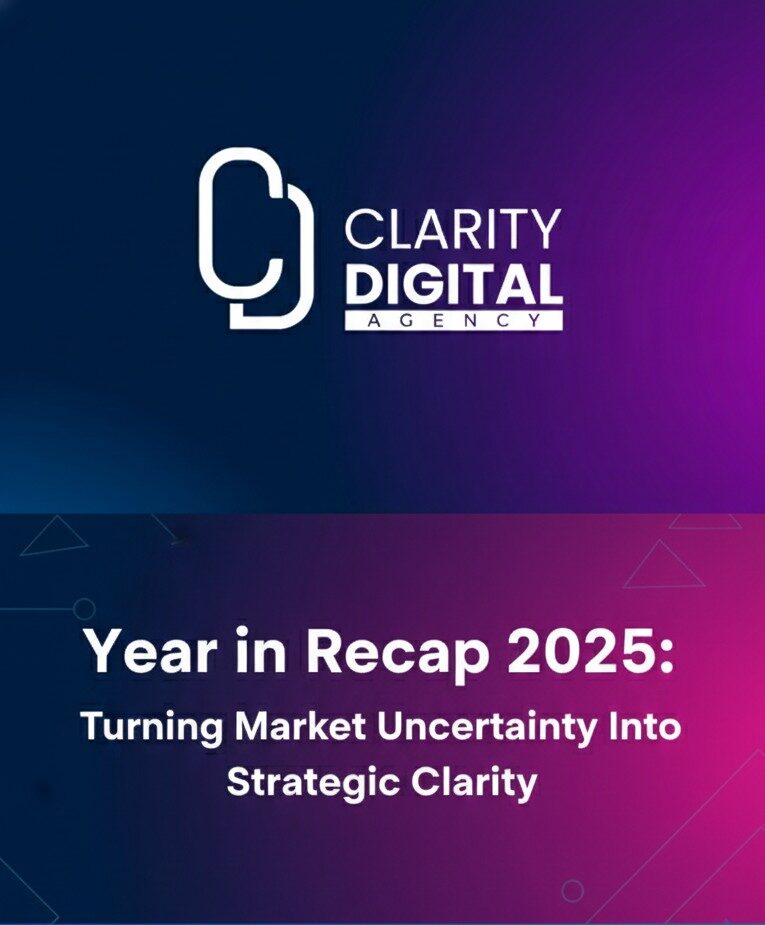One of the best parts about hosting the Clarity Digital Pod is reconnecting with incredible marketers and leaders who helped shape my own career path.
Recently, I sat down with Andy Jolls, a seasoned CMO, fractional executive, and AI consultant. Andy isn’t just another name in my network — he was actually the first CMO I ever worked for, back when I was transitioning from being a purely technical SEO specialist into a broader marketing leader.
This conversation was personal for me — but more importantly, it was full of strategic insights for anyone trying to navigate today’s marketing landscape.
Below’s the full video followed by full summary of my conversation with Andy — a deep dive into marketing leadership, AI transformation, SEO’s evolution, and the changing role of CMOs.
How AI Changed the Game Faster Than Anyone Expected
Andy and I both started from a similar realization:
None of us thought AI would move this fast.
I shared how, back in my computer science days, I took an AI course and thought it was way too theoretical to ever matter.
Fast forward to today — and AI isn’t theoretical anymore. It’s rewiring marketing, business operations, and even customer expectations in real time.
Andy echoed the same sentiment: the arrival of generative AI, starting with tools like ChatGPT, pushed us into a new era almost overnight.
Now the question isn’t “Will AI change marketing?”
The real question is: How fast can marketers adapt — and who’s going to lead that change?
If You Don’t Use AI, You Risk Being Left Behind
One of Andy’s strongest points was simple:
AI is not going to take away marketers’ jobs. But marketers who don’t use AI will lose their jobs to those who do.
Let’s not sugar-coat it.
If you’re a marketing leader, and you’re ignoring AI because you’re “too busy,” you’re effectively choosing to make yourself obsolete.
Andy recommends a practical first step:
- Download an AI app (ChatGPT, Gemini, Claude, take your pick)
- Start using it daily — not just for work tasks, but even for personal things like tutoring your kids or planning a vacation
- Build your comfort level before you’re forced to
Adoption doesn’t have to start with million-dollar projects.
It can (and should) start with daily habits.
Stop Chasing Headlines — Master the Fundamentals First
We touched on the hype cycle around “agentic AI” — the idea of AI tools that can think, reason, and act autonomously.
Andy had a clear warning:
Most companies are not ready for agentic AI.
Too many teams are excited about AI “agents” when they haven’t even fully integrated basic AI into their workflows.
- Automations are not real reasoning.
- Workflow triggers are not intelligent autonomy.
Before trying to sprint into next-gen AI, marketing teams need to crawl and walk — mastering core applications like AI-driven content creation, strategic planning assistance, and operational improvements.
Maturity beats hype. Every time.
How to Build an AI Culture (Without Losing Focus)
One of the smartest frameworks Andy shared was how to embed AI into your team’s DNA without losing focus on business goals.
Instead of setting a vague “AI goal” for the quarter, he recommends this:
- Take your existing OKRs (Objectives and Key Results).
- Feed them into an LLM (large language model).
- Ask AI where it can help accelerate or improve these goals.
This way:
- AI becomes a tool for real, measurable progress.
- Teams stay grounded in actual business impact.
- You avoid “shiny object syndrome” where AI becomes just another innovation lab experiment.
Andy’s point was crystal clear:
AI isn’t a side hustle anymore. It needs to be part of the core operating system of your marketing team.
CMOs Must Lead by Example — Not By Memo
I’ve seen it in my own consulting work too:
Leaders who say, “My team is using AI” but haven’t touched the tools themselves aren’t fooling anyone.
Andy doubled down on this:
Real marketing leadership today means personal engagement with AI.
- You don’t have to become an AI engineer.
- But you do have to roll up your sleeves, experiment, and show your team you’re in the trenches with them.
At Clarity Digital, that’s something we deeply believe too.
Leadership isn’t telling. It’s showing.
If you’re not modeling curiosity, experimentation, and innovation, you’re not leading — you’re managing. And management alone won’t survive what’s coming.
Practical Moves to Speed Up AI Adoption
Andy shared two tactical tips that any marketing team — from startup to enterprise — can adopt immediately:
1. Pay for pro AI licenses for your entire team.
- Don’t make it optional.
- Don’t reimburse after the fact.
- Just do it.
When everyone has access, usage skyrockets — and so does innovation.
2. Move from keyboard to voice interaction.
Andy talked about how he holds conversations with ChatGPT while walking his dogs.
Switching to voice lets you brainstorm, strategize, and problem-solve on the move — capturing moments of creativity that typing would kill.
It’s about working smarter, not harder — and it’s absolutely achievable.
The Future of SEO: Influence Over Traffic
As two marketers who came up through the SEO world, Andy and I couldn’t help but dive into what AI means for search behavior.
Here’s where we landed:
- Traditional SEO isn’t dead — but it’s morphing fast.
- LLMs like ChatGPT still trust Google authority signals, so ranking matters. But it’s not the full story anymore.
Most importantly, the KPI is shifting:
- It’s no longer just about traffic.
- It’s about influence, brand mentions, perceived authority.
AI systems summarize information.
If your brand isn’t visible in their training data (from authoritative sites, strong bylines, or original content), you’re invisible to the next generation of buyers.
SEO is becoming brand SEO.
Content Strategy in the Age of AI
We also talked about content — because frankly, AI is changing the way content gets judged and ranked.
- Keyword stuffing is dead.
- Spun articles are useless.
- Original thought leadership wins.
Large language models understand meaning — not just syntax.
That means your content needs to actually matter to your audience, not just trick a bot.
In the past, you could “out-keyword” the competition.
Today, you have to out-help them.
Insight beats information. Every time.
Is the CMO Role at Risk — Or About to Be Redefined?
I asked Andy about the future of the CMO title, given how short CMO tenure has traditionally been.
His view was nuanced but clear:
- CMOs who stay purely brand-focused, ignoring math and revenue, will struggle.
- CMOs who embrace financial literacy, AI fluency, and creative leadership will thrive.
In fact, AI could actually make CMOs more powerful — if they’re ready to own more of the buyer journey, data strategy, and go-to-market execution.
The “art and science” balance matters more now than ever before.
And the best CMOs of the next decade will be part technologist, part storyteller, part strategist.
Final Reflections: Lessons I’m Taking Forward
Talking with Andy reminded me how much marketing leadership is about constant reinvention.
- Curiosity isn’t optional anymore — it’s mandatory.
- AI isn’t just a tool — it’s becoming the environment we operate in.
- Leadership today means learning publicly, experimenting openly, and building teams that do the same.
Hosting Andy on the Clarity Digital Pod wasn’t just nostalgic — it was energizing.
And it left me with a strong conviction:
The future doesn’t belong to the marketers who resist change. It belongs to the marketers who lead through it.




